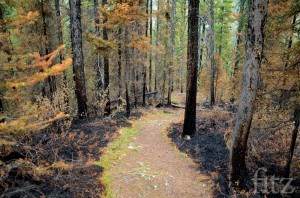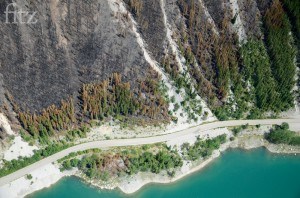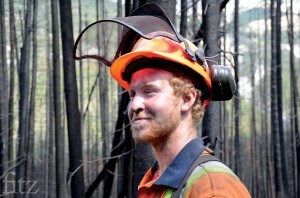
Sprouts of green grass have already begun to peek through the charred earth around Medicine Lake, less than two weeks after a wildfire burned nearly 1,000 hectares of land along the lake’s shores.
The grass is the first sign of the rejuvenating power of fire and in the coming weeks, visitors and locals can expect to see wildlife return to reap the benefits of new growth.
“It’s really changed in there now,” said Jed Cochrane, the Excelsior Wildfire incident commander. “But, it’s also responding really quickly. It’s already started to green up in a lot of spots. We’re seeing green shoots come through and that won’t take long; in a matter of weeks it could green up.”
Parks declared the Excelsior Wildfire under control Monday, July 20 and allowed media to enter the fire zone for the first time that afternoon to see the extent of the burn, as well as to witness the continued efforts of firefighters to extinguish hot spots along the fire’s perimeter.
Visitors and residents were welcomed back to the Maligne Valley Wednesday, July 22, but Parks placed a no-stop zone along the length of the burn area, to ensure public safety while travelling on Maligne Lake Road.
As of press time, Medicine Lake, Watchtower Trail and the burn area remained closed, but the Skyline Trail, Maligne Lake day hikes and backcountry campgrounds had reopened.

Prior to human intervention, fire was a regular part of the ecosystem in Jasper National Park.
Every five to 10 years, low intensity fires would burn through the valley, rejuvenating the forests and providing new growth for wildlife.
But when the Mountain National Parks were formed, fire was seen as something that destroyed the landscape, so wardens were hired primarily to extinguish forest fires. By removing fire from the landscape, vegetation in the parks changed, making forests more dense and less diverse, in turn reducing wildlife habitat.
In recent years, Parks Canada has worked to reintroduce fire on the landscape through prescribed burns and it has opened itself up to allowing natural fires to burn, as long as they don’t threaten public safety or facilities.
Although devastating to look at immediately following a fire, it doesn’t take long before fireweed and grass sprout up, bringing colour to an otherwise stark landscape of blackened trees and charred earth.
“A fire like this, although it was scary for the town and it was a lot of work from the suppression perspective, certainly ecologically it plays a big role in the ecosystem,” said Cochrane. “We’re creating new habitat, we’re opening up a forest—we’re going to see young lodgepole pine in what was generally a spruce stand, we’re going to be opening habitat for elk and there will be berry crops for bears in 10 or 15 years from now.
“Our response and our first priority is always people and property and safety, so that’s our immediate response, but when I put on my ecologist hat in my day job and I look at the fire, the 1,000 hectares we got here is actually excellent from the ecosystem perspective.”

The Excelsior Wildfire, named for its proximity to Excelsior Creek, near the Watchtower Trail head, was first reported at 3:30 p.m. July 9, however photos from a timelapse camera—fortuitously placed by Parks to capture photos of the draining and filling of Medicine Lake—shows the fire ignited at 2:30 p.m. on the north side of Excelsior Creek.
It was caused by a lightning strike on July 1, which smouldered underground before finally igniting eight days later after days of hot, dry weather.
After the fire was reported, Parks staff, along with help from the Jasper RCMP, immediately closed Maligne Lake Road and turned their focus to evacuating the valley. Over the course of two days, 1,000 people were evacuated, either by helicopter, ATV, bike or in their own vehicles, depending on where they were located.
That first day, the fire spread south toward Medicine Lake and along the lake’s shores.
“In about six hours it did six kilometres,” said Cochrane, the fire and vegetation specialist for Lake Louise, Yoho and Kootenay national parks. “In the mountains, in a conifer fuel type, that’s fast—that’s an aggressive, fast wildfire.”
Interestingly—and shockingly—one small topographical feature stopped the fire from burning up the slopes along Medicine Lake, reducing the overall size of the fire.
“What happened is there’s a bench feature in there, it’s not quite as steep,” explained Cochrane, “and that bench seems to be catching a lot of the moisture from the hills up above and creating a wetter environment with a lot wetter stuff like moss, labrador tea, open spruce stands, so the fire came into that and just stopped.
“It burned in this interesting line all the way across and that’s relatively unique. We were very shocked to see that it hadn’t moved all the way up the slope. We were actually really thankful that it didn’t.”
As well as burning along the shore, the fire also jumped the road, near the Medicine Lake lookout and burned the vegetation growing on Medicine Slabs.
“It did cross the road that first day in a spectacular fashion,” said Cochrane. “In fact, some of the most intense and hot fire behaviour was right there at the road. It came across really hot.”

For fear that the fire would continue burning at such a great intensity and with such great speed, Parks quickly turned its sights to protecting the townsite, in case the fire changed directions.
Fortunately, that plan was never put into action and instead fire crews were able to start attacking the fire directly, after five millimetres of rain fell between Friday evening and Saturday morning.
“That was really the turning point on the fire,” said Cochrane. “That [rain] bought us at least three or four days of time, so what we did then was we moved all of that strategy and put it right in on the fire’s perimeter, in what we call direct attack.”
That’s when firefighters were put on the ground and helicopters were deployed to start bucketing water from the air.
As of Monday, there were 77 firefighters working on the Excelsior Wildfire, but that number was expected to drop as the week progressed and their resources were no longer needed.
The remaining fire crews are checking for hot spots along the perimeter of the fire. When they find them, they dig them up and put them out to ensure the fire doesn’t reignite.
“We’ll start scaling down now that we have a better handle on things,” said Cochrane. “We now have helipads across the fire; we have access; we’ve had people walk the whole perimeter both ways all the way around.
“As long as the fire’s well inside the black and doesn’t have anywhere to strike to, then it’ll be OK.
“But, it’ll be monitored for the rest of the summer.”
Nicole Veerman
[email protected]
